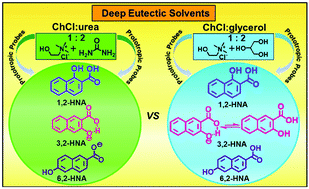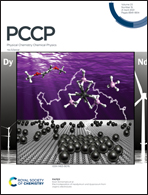Prototropic forms of hydroxy derivatives of naphthoic acid within deep eutectic solvents†
Abstract
Deep eutectic solvents (DESs) are not only recognized as benign and inexpensive alternatives to ionic liquids, they offer a unique solvation milieu due to the varying H-bonding capabilities of their constituents. Proton-transfer involving a probe and its prototropic forms strongly depend on the H-bonding nature of the solubilizing media. The presence of prototropic forms of three probes, 1-hydroxy-2-naphthoic acid (1,2-HNA), 3-hydroxy-2-naphthoic acid (3,2-HNA), and 6-hydroxy-2-naphthoic acid (6,2-HNA) is investigated in two DESs, named ChCl:urea and ChCl:glycerol, constituted of H-bond acceptor choline chloride and different H-bond donors, urea and glycerol, respectively, in a 1 : 2 mole ratio under ambient conditions. While 1,2-HNA and 3,2-HNA exhibit an intramolecular H-bonding ability, 6,2-HNA does not. In contrast to common polar solvents, where the monoanionic emitting form of 1,2-HNA is also supported along with the neutral one, in both the DESs only the neutral emitting form exists. Addition of acid to the two DESs, respectively, fail to generate the monocationic form of the probe. Addition of a base to ChCl:urea results in the generation of the monoanionic form; even a very high strength of the base fails to generate the monoanionic emitting form in ChCl:glycerol. Relatively higher H-bond donating acidity of ChCl:glycerol results in added hydroxyl getting involved in H-bonding with alcohol functionalities of ChCl:glycerol leading to the absence of proton extraction to create the monoanionic form of the probe. Only the monoanionic emitting form of 3,2-HNA is present in ChCl:urea; in ChCl:glycerol, due to its higher H-bond donor acidity, the neutral emitting form is also detected. Addition of high strength of acid to ChCl:urea does result in formation of the neutral emitting form. Addition of an aqueous base results in the formation of the dianionic form of 3,2-HNA in ChCl:urea; however, in ChCl:glycerol, the added base fails to convert the neutral form of this probe to the monoanionic form as efficiently as that in ChCl:urea. The monoanionic (carboxylate) form of 6,2-HNA exits in ChCl:urea, whereas the neutral form is present in ChCl:glycerol due to its higher H-bond donating acidity. Addition of an acid can induce a shift in prototropic equilibrium towards the neutral form of 6,2-HNA in ChCl:urea; no change is observed in the behavior of this probe in ChCl:glycerol as the acid is added. Both the DESs support the dianionic form of 6,2-HNA in the presence of the base; the added base helps extract both –OH and –COOH protons of this probe. The H-bond donor component of the DES is clearly established to play a critical role in the prototropic behavior of the probe.



 Please wait while we load your content...
Please wait while we load your content...